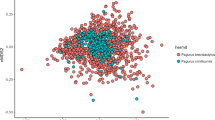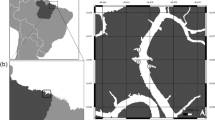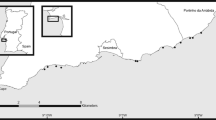Abstract
The spider crab Inachus phalangium is common in the sublitoral fringe of the Mediterranean Sea and north-eastern Atlantic Ocean, where it can be found in association with the snakelocks sea anemone Anemonia viridis. Studies concerning its activity patterns and the role of the host sea anemone are lacking. Our study aimed at investigating activity rhythms and resources utilization of I. phalangium reared in captivity. The main behavioral traits exhibited by I. phalangium are performed mostly at night. Two experiments were designed, one examined the time budget of various behavioral acts and the degree of association with the sea anemone, the other analyzed the behavioral response to algae and anemones. We showed that algae have a crucial role in the biology of I. phalangium and that crabs are ready to leave the protection of their host to obtain them. Algae represent both the major component of the diet and one of the most utilized sources of masking material of I. phalangium, which provide, together with specialized cryptic behaviors, protection against predators. Although our data suggest that the association with A. viridis is not obligatory, but the role of the snakelocks sea anemone in the life of I. phalangium is still central, both as an anti-predatory defense and as a nutritional source. The association of I. phalangium with algae and the anemone is a facultative biotrophic commensalistic symbiosis.



Similar content being viewed by others
References
Breton G, Sygut A, Oms R (2004) Approche expérimentale des stratégies de protection du crabe Inachus phalangium (Fabricius, 1775). Bull Soc Geol Norm Amis Mus Havre 90:61–69
Diesel R (1986a) Optimal mate searching strategy in the symbiontic spider crab Inachus phalangium (Decapoda). Ethology 72:311–328
Diesel R (1986b) Population dynamics of the commensal spider crab Inachus phalangium (Decapoda: Maiidae). Mar Biol (Hist Arch) 91:481–489
d’Udekem d’Acoz C (1999) Inventaire et distribution des crustacés décapodes de l’Atlantique nord-oriental, de la Méditerranée et des eaux continentales adjacentes au nord de 25°N. Muséum National d’Histoire Naturelle, Paris
Hartnoll RG (1970) The relationship of an amphipod and a spider crab with the snakelocks anemone. Annu Rep Mar Biol Stn Port Erin 83:37–42
Parapar J, Fernández L, González-Gurriarán E, Muiño R (1997) Epibiosis and masking material in the spider crab Maja squinado (Decapoda:Majidae) in the Ría de Arousa (Galicia, NW Spain). Cah Biol Mar 38:221–234
Rorandelli R, Gomei M, Cannicci S, Vannini M (2006) Feeding and masking selection in Inachus phalangium (Decapoda, Majidae): dressing up has never been so complicated. Mar Ecol Prog Ser (in press)
Shick JM (1991) A functional biology of sea anemones. Chapman and Hall, London
Spotte S (1996) Supply of regenerated nitrogen to sea anemone by their symbiotic shrimp. J Exp Mar Biol Ecol 198:27–36
Stachowicz JJ, Hay ME (1999) Reducing predation through chemically mediated camouflage: indirect effects of plant defences on herbivores. Ecology 80:495–509
Svoboda A, Svoboda B (1975) The Mediterranean anemone shrimps of the genus Periclimenes Costa (Decapoda, Palaemonidae). PSZN 39:345–346
Weinbauer G, Nussbaumer V, Patzner RA (1982) Studies on the relationship between Inachus phalangium (Maiidae) and Anemonia sulcata in their natural environment. Mar Ecol 3:143–150
Wicksten MK (1980) Decorator crabs. Sci Am 242:146–154
Wicksten MK (1993) A review and a model of decorating behavior in spider crabs (Decapoda, Brachyura, Majidae). Crustaceana 64:314–325
Wirtz P, Diesel R (1983) The social structure of Inachus phalangium, a spider crab associated with the sea anemone Anemonia sulcata. Z Tierpsychol 62:209–234
Woods CMC, McLay CL (1994) Masking and ingestion preferences of the spider crab Notomithrax ursus (Brachyura: Majidae). N Z J Mar Freshw Res 28:105–111
Woods CMC, Page MJ (1999) Sponge masking and related preferences in the spider crab Thacanophrys filholi (Brachyura: Majidae). Mar Freshw Res 50:135–143
Acknowledgments
We thank Angela Pasqualin, Franco Todesco for data collection, Dr. Sara Fratini and Gianna Innocenti for manuscript revision, two anonymous referees for their useful comments. This study was funded by the University of Florence and by MURST (COFIN project). R.R. was supported by a PhD fellowship from the Italian Ministry of Education, University and Research (MIUR). All the conducted experiments comply with the current Italian laws.
Author information
Authors and Affiliations
Corresponding author
Additional information
Communicated by R. Cattaneo-Vietti, Genova.
Rights and permissions
About this article
Cite this article
Rorandelli, R., Bartolini, F., Gomei, M. et al. Observations in captivity of the activity patterns and resources utilization of the spider crab Inachus phalangium (Decapoda, Majidae). Mar Biol 151, 1111–1116 (2007). https://doi.org/10.1007/s00227-006-0550-7
Received:
Accepted:
Published:
Issue Date:
DOI: https://doi.org/10.1007/s00227-006-0550-7




